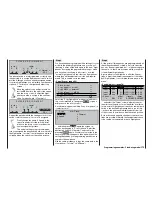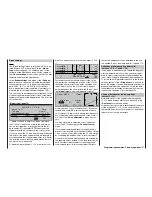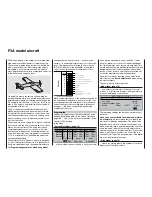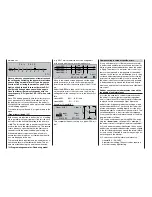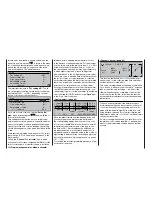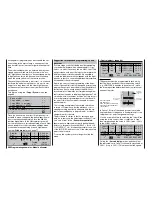
188
Delta / fl ying wing model aircraft
On page 158, where the section on fi xed-wing mo-
del programming starts, you will fi nd general notes re-
garding the procedure for installing and setting up the
RC system in a model, and – of course – this also ap-
plies to deltas and fl ying wings. The information on
test-fl ying and refi ning the settings is also relevant, in-
cluding the section on programming fl ight phases.
In their characteristic shape and geometry, deltas and
fl ying wings differ very clearly from “normal” models
even at fi rst sight, but the differences in the servo ar-
rangement required are rather more subtle. The “clas-
sic” model delta or fl ying wing generally has only two
control surfaces, which act both as ailerons (moving
in opposite directions) and as elevators (moving in the
same direction), in a similar way to the superimposed
rudder / elevator functions of a V-tail.
More recent designs tend to be more complex; one
(or two) inboard control surfaces may be set up to act
purely as elevators, while the outboard ailerons also
act as elevators, but to a reduced extent. If a fl ying
wing has four or even six wing control surfaces, it is
certainly feasible nowadays to set them up with cam-
ber-changing fl ap functions and / or even a butterfl y
(crow) system. However, the servos for all these mo-
del confi gurations must be connected to the receiver
as follows (see also page 37):
Please also read the notes on operating six-fl ap
wings with PCM20 and SPCM20 receivers on pages
39 and 137.
In accordance with the receiver output sequence, the
fi rst step here is to move to the menu ...
»Model type« (page 70)
SEL
Offset
+100%
2 AIL
4 WK
D e l t / f l .w i n g
M O D E L T Y P E
Tail type
Aileron/camber flaps
Brake
Input 1
Motor on C1
None
… and select the following settings:
“
Motor on C1
” “none” or “Throttle min forward / back”
“Tail”:
“Delt/fl
.wing”
“Aileron / camber fl aps”:
“2AIL” (appears automatically)
If necessary, expand the “2 AIL” entry
by one, two or four camber-changing
fl aps (“1 FL”, “2 FL” or “4 FL”).
“
Brake
”:
can be ignored; it is only of interest if
the model is a delta or fl ying wing of
the “2 AIL 1 / 2 / 4 FL” type. In this
case see the section entitled “Brake”
on page 71.
The primary function of these settings is to defi ne the
range of “wing mixers” which the software will offer. To
cater for all the variants, the following section discus-
ses the options separately for two-fl ap and multi-fl ap
models:
Delta / fl ying wing of the “2AIL” type
SEL
Offset
+100%
2 AIL
D e l t / f l .w i n g
M O D E L T Y P E
Tail type
Aileron/camber flaps
Brake
Input 1
Motor on C1
None
If you retain the standard “2AIL” setting in the “Aile-
rons / camber fl aps” line, the software automatical-
ly mixes the elevator and ailerons in the correct man-
ner, including the trim function. In this case the mixer
ratios can be adjusted by varying the Dual Rate set-
tings in the »
Dual Rate / Exponential
« menu (see
page 86).
It makes sense in any case to enter settings in the
“Aileron 2
4 rudder” line of the menu …
»Wing mixers« (page 110)
… and you may wish to “play” a little with low differen-
tial values, but do take care, as differential can have
unexpected effects on the handling characteristics of
a fl ying wing.
SEL
=>
+ 50%
+ 10%
2–>4
Brake settings
Aileron
rudder
Aileron differential
W I N G M I X E R S
Due to the unique characteristics of this type of mo-
del, differential settings other than very low values
Programming examples: Fixed-wing model
Battery
Free, or aux. function
Right fl ap / elevator
Left fl ap / elevator
Free, or aux. function (e. g. right rudder)
Rudder (or left rudder)
Right elevon
Left elevon
Airbrake or throttle or speed controller (elec-
tric model)
Batt
9
8
7
6
5
4
3
2
1
10
Free, or aux. function or left FL2 / elevator
Free, or aux. function or right FL2 / elevator
Receiv
er
Summary of Contents for mx-24s
Page 1: ...1...
Page 19: ...19 For your notes...
Page 35: ...35 For your notes...
Page 41: ...41 41 For your notes...
Page 57: ...57 For your notes...
Page 63: ...63 63 For your notes...
Page 69: ...69 69 For your notes...
Page 85: ...85 85 For your notes...
Page 99: ...99 For your notes...
Page 143: ...143 For your notes...
Page 191: ...191 For your notes...
Page 212: ...212 212 For your notes...
Page 213: ...213 213 For your notes...
Page 214: ...214 For your notes...
Page 216: ...216...


